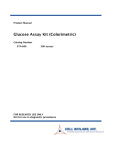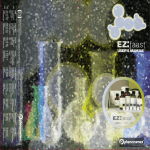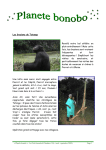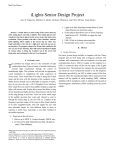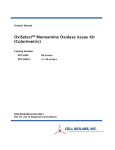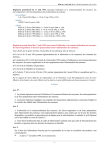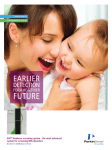Download - Cell Biolabs, Inc.
Transcript
Product Manual Glucose Assay Kit (Fluorometric) Catalog Number STA-681 500 assays FOR RESEARCH USE ONLY Not for use in diagnostic procedures Introduction Glucose is a sugar used as an important source of energy in plants, prokaryotes and eukaryotes via processes such as respiration and fermentation. In plants, algae, and cyanobacteria, the energy of light is synthesized into the storage form of sugars such as glucose. More specifically, in a downstream process known as the Calvin cycle, carbon dioxide is incorporated into organic carbon compounds, like ribulose bisphosphate. Using ATP and NADPH from upstream light-dependent reactions, the resulting compounds are then reduced and removed to form further carbohydrates, such as glucose. In animals, through the process of glycolysis followed by the citric acid cycle, glucose is broken down to water and CO2, resulting in energy from ATP formation. Glucose is often stored as a polymer such as glycogen. In humans, glucose is commonly measured in blood samples. Bloodstream levels of glucose are normally under tight regulation (Table 1); however, high levels measured in fasting individuals may indicate prediabetes or diabetes. Animal Human Cow Sheep Goat Cat Dog Horse Pig Rabbit Llama Mountain Goat Beluga Whale White Rhinoceros Harp Seal Hooded Seal Blood Glucose Range (mg/dL) (mM) 79-110 4.4-6.1 42-75 3.7-6.6 44-81 3.9-7.2 48-76 4.2-6.7 61-124 5.4-11.0 62-108 5.5-9.5 62-114 5.5-10.1 66-116 5.8-10.3 75-155 6.6-13.7 90-140 8.0-12.4 26-181 2.3-16.0 94-115 8.3-10.2 28-140 2.5-12.4 88-218 7.8-19.3 135-283 11.9-25.0 Table 1. Range of blood glucose levels in common animals (Ref. 1). Cell Biolabs’ Glucose Assay Kit is a simple fluorometric assay that measures the amount of total glucose present in foods or biological samples in a 96-well microtiter plate format. Each kit provides sufficient reagents to perform up to 500 assays, including blanks, glucose standards and unknown samples. Sample glucose concentrations are determined by comparison with a known glucose standard. The kit has a detection sensitivity limit of 1.56 µM glucose. 2 Assay Principle Cell Biolabs’ Total Glucose Assay Kit measures total glucose within food or biological samples. Glucose is oxidized by glucose oxidase into D-gluconic acid plus hydrogen peroxide. The hydrogen peroxide is then detected with a highly specific fluorometric probe. Horseradish peroxidase catalyzes the reaction between the probe and hydrogen peroxide, which bind in a 1:1 ratio. Samples are compared to a known concentration of glucose standard within the 96-well microtiter plate format. Samples and standards are incubated for 45 minutes and then read with a standard 96-well fluorometric plate reader (Figure 1). Figure 1. Glucose assay principle. Related Products 1. STA-398: Free Glycerol Assay Kit (Colorimetric) 2. STA-399: Free Glycerol Assay Kit (Fluorometric) 3. STA-670: Homocysteine ELISA Kit 4. STA-671: S-Adenosylhomocysteine (SAH) ELISA Kit 5. STA-672: S-Adenosylmethionine (SAM) ELISA Kit 6. STA-671-C: S-Adenosylmethionine (SAM) ELISA and S-Adenosylhomocysteine (SAH) ELISA Combo Kit 7. STA-674: Glutamate Assay Kit 8. STA-675: Hydroxyproline Assay Kit 9. STA-680: Glucose Assay Kit (Colorimetric) 10. STA-682: Total Carbohydrate Assay Kit 3 Kit Components Box 1 (shipped at room temperature) 1. Glucose Standard (Part No. 268001): One 500 µL tube at 400 mM 2. 10X Assay Buffer (Part No. 268002): One 25 mL bottle 3. Fluorometric Probe (Part No. 268101): One 250 µL amber tube 4. HRP (Part No. 234402): One 100 μL tube at 100 U/mL Box 2 (shipped on blue ice packs) 1. Glucose Oxidase (Part No. 268004): One 500 µL tube at 100U/mL Note: One unit is defined as the amount of enzyme that will oxidize 1.0 micromole of beta-D-glucose to D-gluconic acid and hydrogen peroxide per minute at pH 5.1 at 35°C. Materials Not Supplied 1. Distilled or deionized water 2. 1X PBS 3. 10 μL to 1000 μL adjustable single channel micropipettes with disposable tips 4. 50 μL to 300 μL adjustable multichannel micropipette with disposable tips 5. Standard 96-well fluorescence black microtiter plate and/or black cell culture microplate 6. Multichannel micropipette reservoir 7. Fluorescence microplate reader capable of reading excitation in the 530-570 nm range and emission in the 590-600 nm range. Storage Upon receipt, store the Glucose Standard, Fluorometric Probe, HRP, and Glucose Oxidase at -20ºC. The Fluorometric Probe is light sensitive and must be stored accordingly. Avoid multiple freeze/thaw cycles. Store the 10X Assay Buffer at room temperature. Preparation of Reagents • 1X Assay Buffer: Dilute the stock 10X Assay Buffer 1:10 with deionized water for a 1X solution. Stir or vortex to homogeneity. • Reaction Mix: Prepare a Reaction Mix by diluting the Fluorometric Probe 1:100, HRP 1:500, and Glucose Oxidase 1:50 in 1X Assay Buffer. For example, add 50 μL Fluorometric Probe stock solution, 10 μL HRP stock solution, and 100 μL of Glucose Oxidase to 4.84 mL 1X Assay Buffer for a total of 5 mL. The above example Reaction Mix volume is enough for 100 assays. The Reaction Mix is stable for 1 day at 4ºC. Note: Prepare only enough for immediate use by scaling the above example proportionally. 4 Preparation of Samples • • • • Cell culture supernatants: Cell culture media formulated with glucose should be avoided. To remove insoluble particles, centrifuge at 10,000 rpm for 5 min. The cell conditioned media may be assayed directly or diluted as necessary. Prepare the Glucose standard curve in non-conditioned media without glucose. Note: Maintain pH between 7 and 8 for optimal working conditions as the Fluorometric Probe is unstable at high pH (>8.5). Tissue lysates: Sonicate or homogenize tissue sample in cold PBS or 1X Assay Buffer and centrifuge at 10000 x g for 10 minutes at 4°C. Perform dilutions in 1X Assay Buffer. Cell lysates: Resuspend cells at 1-2 x 106 cells/mL in PBS or 1X Assay Buffer. Homogenize or sonicate the cells on ice. Centrifuge to remove debris. Cell lysates may be assayed undiluted or diluted as necessary in 1X Assay Buffer. Serum, plasma or urine: To remove insoluble particles, centrifuge at 10,000 rpm for 5 min. Dilute the supernatant from 1:50 to 1:200 with 1X Assay Buffer just prior to performing the assay. Notes: • All samples should be assayed immediately or stored at -80°C for up to 1-2 months. Run proper controls as necessary. Optimal experimental conditions for samples must be determined by the investigator. Always run a standard curve with samples. • Samples with NADH concentrations above 10 μM and glutathione concentrations above 50 μM will oxidize the Fluorometric Probe and could result in erroneous readings. To minimize this interference, it is recommended that superoxide dismutase (SOD) be added to the reaction at a final concentration of 40 U/mL (Tatyana et al, Ref. 2). • Avoid samples containing DTT or β-mercaptoethanol since Resorufin is not stable in the presense of thiols (above 10 μM). Preparation of Standard Curve Prepare fresh Glucose standards before use by diluting in 1X Assay Buffer. First, dilute the stock Glucose Standard 400 mM solution 1:10 in 1X Assay Buffer for a 40 mM Glucose Solution (e.g. add 5 μL of the stock 400 mM Glucose Standard to 45 μL of 1X Assay Buffer). Use the 40 mM Glucose Solution to prepare a series of the remaining Glucose standards according to Table 1 below. Standard Tubes 1 2 3 4 5 6 7 8 40 mM Glucose Solution (µL) 4 250 of Tube #1 250 of Tube #2 250 of Tube #3 250 of Tube #4 250 of Tube #5 250 of Tube #6 0 1X Assay Buffer (µL) 1596 250 250 250 250 250 250 250 Table 2. Preparation of Glucose Standards 5 Glucose (µM) Glucose (mg/dL) 100 50 25 12.5 6.25 3.13 1.56 0 1.8 0.9 0.45 0.225 0.113 0.056 0.028 0 Assay Protocol 1. Prepare and mix all reagents thoroughly before use. Each sample, including unknowns and standards, should be assayed in duplicate or triplicate. 2. Add 50 µL of each glucose standard or unknown sample into wells of a black microtiter plate suitable for a fluorescence plate reader. 3. Add 50 µL of Reaction Mix to each well. Mix the well contents thoroughly and incubate for 30-45 minutes at 37ºC protected from light. Note: This assay is continuous (not terminated) and therefore may be measured at multiple time points to follow the reaction kinetics. 4. Read the plate with a fluorescence microplate reader equipped for excitation in the 530-570 nm range and for emission in the 590-600 nm range. 5. Calculate the concentration of glucose within samples by comparing the sample RFU to the standard curve. Example of Results The following figures demonstrate typical Glucose Assay Kit (Fluorometric) results. One should use the data below for reference only. This data should not be used to interpret or calculate actual sample results. Figure 2: Glucose standard curve. 6 Figure 3: Glucose detection in human serum using the Glucose Assay Kit (Fluorometric). References 1. Kahn, C. M., ed. (2005) Merck Veterinary Manual (9th ed.). Whitehouse Station: Merck & Co. 2. Tatyana, V., et al. Neurochem. (2001) 79: 266. 3. Aranoff S.L., Berkowitz K., Shreiner B., and Want L. (2004) Diabet. Spectrum 17:183-190. 4. McMillan J.M. (1990) Clin. Methods 3rd Ed: The History, Physical, and Lab. Examinations. Ch. 141: 662-665. 5. Alonso M.D., Lomako J., Lomako W.M, and Whelan W.J. (1995) Faseb J., 9:1126-1137. 6. Shao J., Wang Z, Yang T., Ying H., Zhang Y, and Liu S. (2015) Int. J., Endocrinol. 2015: 1-9. Warranty These products are warranted to perform as described in their labeling and in Cell Biolabs literature when used in accordance with their instructions. THERE ARE NO WARRANTIES THAT EXTEND BEYOND THIS EXPRESSED WARRANTY AND CELL BIOLABS DISCLAIMS ANY IMPLIED WARRANTY OF MERCHANTABILITY OR WARRANTY OF FITNESS FOR PARTICULAR PURPOSE. CELL BIOLABS’s sole obligation and purchaser’s exclusive remedy for breach of this warranty shall be, at the option of CELL BIOLABS, to repair or replace the products. In no event shall CELL BIOLABS be liable for any proximate, incidental or consequential damages in connection with the products. 7 Contact Information Cell Biolabs, Inc. 7758 Arjons Drive San Diego, CA 92126 Worldwide: +1 858 271-6500 USA Toll-Free: 1-888-CBL-0505 E-mail: [email protected] www.cellbiolabs.com 2015: Cell Biolabs, Inc. - All rights reserved. No part of these works may be reproduced in any form without permissions in writing. 8








